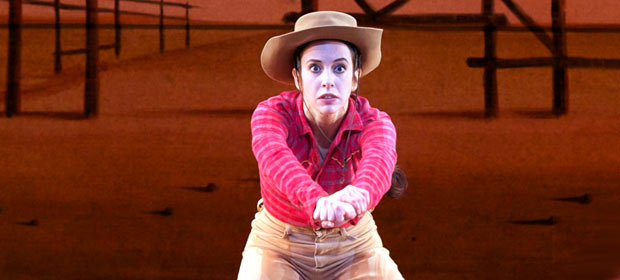
© Gene Schiavone. (Click image for larger version)
American Ballet Theatre
Theme and Variations, Pillar of Fire, Rodeo
Washington, Kennedy Center Opera House
24 March 2015
www.abt.org
www.kennedy-center.org
Celebrating its 75th anniversary, American Ballet Theatre opened its spring season at the Kennedy Center Opera House with a triple bill of the company’s best-loved, enduring classics: George Balanchine’s Theme and Variations, Antony Tudor’s Pillar of Fire and Agnes de Mille’s Rodeo. All three ballets were created in the 1940s and all three played important roles in cementing the company’s future in early years of its existence.
After all this time, De Mille’s Rodeo (1942), a romantic story that takes place on a ranch, remains as charming, entertaining and fresh as ever. It centers on a theme as old as the world itself: what a nice girl has to do to get a suitable man. The plot revolves around a tomboy (called here the Cowgirl) in love with a man who doesn’t return her affection. To make the matter worse, the guy is smitten with the pretty and flirty daughter of the ranch’s owner.
A delightful comedy, complete with an invigorating square dance and a virtuoso tap-dance sequence, Rodeo offers a host of vivid personages, but the role of the Cowgirl stands out from the rest for its rich theatricality and unique movement vocabulary.
Rodeo’s heroine is an indomitable rebel and a sweetheart, a free spirit and a shy misfit, all in one. Her willpower and unwillingness to give up her dreams collide with her delightful charm and innocence. She faithfully follows her heart; and when her heart gets broken she gathers its pieces and keeps on going, holding her chin up and hiding her tears.
Watching the performance of Xiomara Reyes in the main role, I kept thinking that ABT is about to bid farewell to the finest Cowgirl in the company’s history. Over the years, the Cuban-born ballerina put an indelible stamp on this role, making it truly her own. Reyes will be retiring from ABT in May after a 14-year-long distinguished career with the company, but before then she will be leading Rodeo twice more as part of the ABT spring season at the Metropolitan Opera House in New York. These performances are not to be missed.
Apart from her phenomenal technical prowess, Reyes gets her heroine’s inner spirit right. She combines the Cowgirl’s child-like sweetness and purity with an unshakable determination and winning attitude in her fight for happiness, never descending into melodrama or overplaying comic gestures.
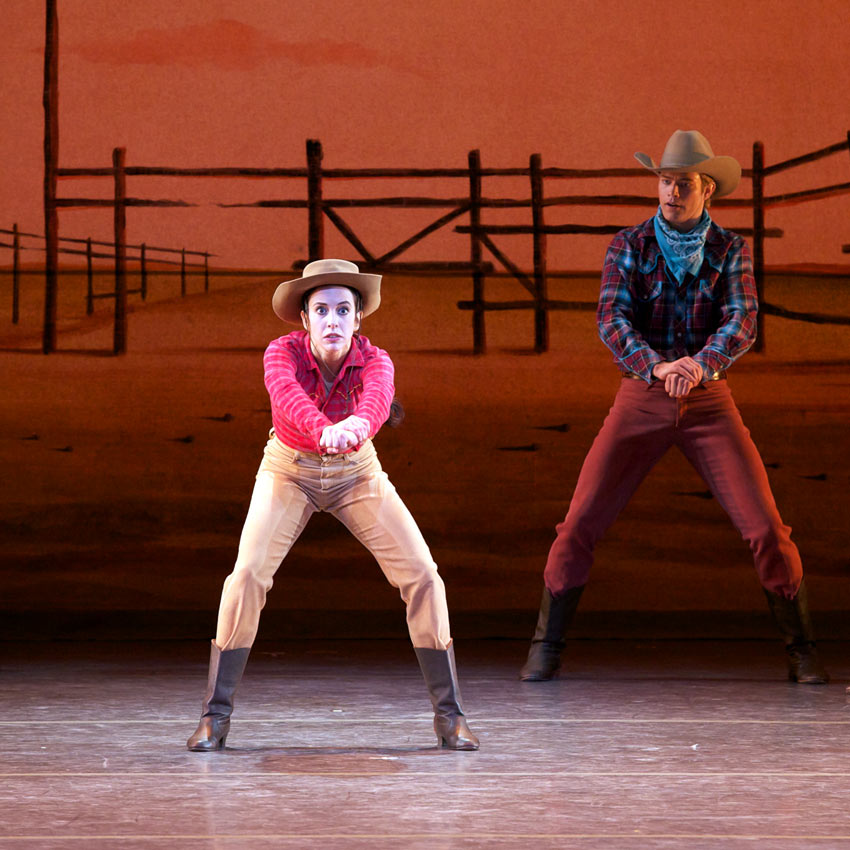
© Gene Schiavone. (Click image for larger version)
It was heart-rending to see Reyes’s character desperately trying to fit in and be “one of the guys” as she awkwardly imitated the cowboys’ bowlegged, rolling walk and bravely attempted to compete in their riding and roping games. It was even more agonizing to see her dismissed by the men who, bemused by her stubbornness and gawkiness, perceived her more as a hapless chump than a potential date. In every scene, Reyes was entirely convincing and sincere, her comic timing flawless and her dancing impeccable.
Nothing can ignite a cowboy’s imagination better than the fluttery ruffles of a voluminous skirt. This is the lesson the Cowgirl has to learn to become attractive to the ranch’s male contingent. Putting on a dress in screaming yellow for the final Hoe-Down, Reyes’s character was as adorable as she was amusing. Yet even in the lady-like gown, she remained true to herself – a spunky, good-natured firecracker with a heart of gold.
The rest of the cast was in excellent form as well. James Whiteside was perfectly amiable and wonderfully witty as the Champion Roper – the guy whose big-brotherly feelings for Cowgirl turned into sincere love and affection and who at the end deservedly won her heart with his kindness as well as his prodigious tap-dancing skills. The excellent Roman Zhurbin shone as the swaggering Head Wrangler, the man who initially set the Cowgirl’s heart aflame. Lauren Post was lovely and appropriately coquettish in the role of the Ranch Owner’s Daughter.
The incomparable beauty of Aaron Copland’s exuberant score permanently secured Rodeo’s enormous popularity and staying power. The music – emotionally rich, spacious and vibrant – beautifully conveys the sense of freedom and expansiveness, unearthing a sound that is distinctively American and adding to the ballet’s authentic appeal. Charles Barker led the Opera House orchestra in a rousing rendition of the famous score, beautifully accentuating the music’s lush dramatic nuances and colors.
Pillar of Fire (1942) was the first ballet Antony Tudor made for ABT after arriving from his native England. Just like de Mille’s Rodeo, Tudor’s masterpiece deals with the theme of getting a man; but if Rodeo is a charming comedy, Pillar of Fire is a grim psychological drama even with its happy end.
Set to Arnold Schoenberg’s “Verklärte Nacht” (Transfigured Night), Pillar of Fire is a timeless study of a repressed, self-destructive soul. A young woman, Hagar, lives in a small Puritan town with her two sisters. Well aware of the strict moral codes of her community, the chaste and lonely Hagar fears to become a spinster like her older sister; she desperately longs for love and intimacy. She suppresses her feelings toward a man she loves, fearing that he will not reciprocate her attraction, and, in a moment of desperation, engages in a brief relationship with a lowlife who cares nothing about her. Her ensuing emotional and physical suffering and anguish form the core of the ballet.
As Hagar, Gillian Murphy gave a realistic and deeply moving portrayal of the distressed heroine, poignantly expressing in movement her troubled consciousness and emotional isolation. She deftly conveyed Hagar’s dual tragedy: her heroine was not only trapped in her stifling provincial town, but also was a prisoner of her own terrified mind. It’s through her eyes we viewed the action onstage. Murphy etched out the pain and the horror of Hagar’s inner world with powerful dramatic skill, adhering to Tudor’s key principle that “the dancing is the acting.”
The irresistible Marcelo Gomes gave a powerful account of Hagar’s seducer, called here The Young Man from the House Opposite. Alexandre Hammoudi delivered a thoughtful and intelligent interpretation of the Friend, the man whose understanding and compassion saved the doomed heroine from a seemingly inevitable tragedy. Stella Abrera imbued the role of the Eldest Sister – an unflinching safeguard of the Puritan dogmas of morality and chastity – with an air of harrowing cruelty and disdain; and as the Youngest Sister, the lovely Cassandra Trenary, in a fetching pink dress, made her character as enchanting with the local men and as cruel with Hagar as her role demanded and even more, bringing the notion of sibling rivalry to new heights.

© Gene Schiavone. (Click image for larger version)
The program opened with a somewhat underwhelming rendition of Balanchine’s 1947 classic Theme and Variations. Choreographed to the final movement of Tchaikovsky’s Suite No. 3 for Orchestra in G Major, this ballet is a dazzling exemplar of the 19th-century classical ballet style, in which Balanchine pays homage to his alma mater, The Imperial Theater of St. Petersburg, and to the musical genius of Tchaikovsky. The stage décor, with its imposing colonnades and magnificent chandeliers, evokes a grand ballroom of the Imperial Palace. The choreography is remarkable in its use of geometric patterns and inventive groupings and is perfectly attuned to Tchaikovsky’s glorious music. But during the opening night performance, the dancing of the principals felt labored most of the time and never really took flight. In the ballerina role, Isabella Boylston couldn’t capture the majestic glamour and stately elegance of her role. Her cavalier, Daniil Simkin, struggled in his solo variation; his partnering looked shaky and tense. Yet the ensemble made a good impression, providing some of the most rewarding moments of the performance, concluding with a brilliant polonaise danced with the appropriate ceremonial flair by all.













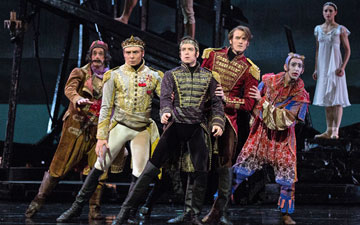
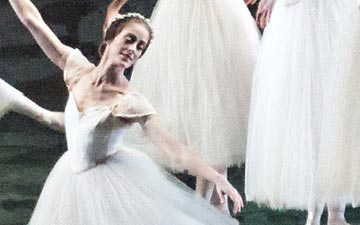

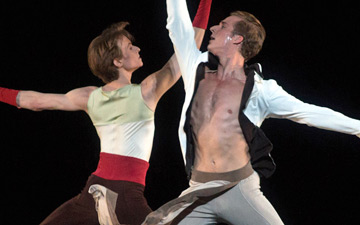
You must be logged in to post a comment.